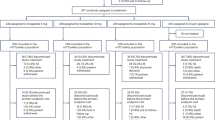Abstract
The treatment of NIDDM patients with secondary failure to sulphonylurea is a common problem. We performed a crossover study in 50 NIDDM patients with secondary failure to gliben-clamide by comparing the addition to sulphonylurea of either a low-dose bedtime NPH insulin or a t.i.d. oral metformin and by analyzing treatment efficacy in relation to patient and disease characteristics. Both combined therapies clearly improved glycaemic control. HbA1c were similarly reduced by the addition of either bedtime NPH insulin (7.6±0.34 vs 8.7±0.35, p<0.01) or metformin (7.6±0.22 vs 8.6±0.31, p<0.01). Also fasting plasma glucose (FPG) and post-prandial plasma glucose (PPPG) significantly decreased (p<0.01) with both treatments. Bedtime NPH insulin was more effective on FPG reduction than metformin (−36±2% vs −25±2%, p<0.01); in contrast, metformin addition was more effective on PPPG reduction than bedtime NPH insulin addition (−30±2% vs 20±3%, p<0.01). Serum cholesterol was marginally but significantly decreased after metformin (5.49±0.19 vs 5.91 ±0.18 mM, p<0.05) but not after NPH insulin. Body weight increase was significantly greater after insulin addition than after metformin (1.47±0.25 Kg vs 0.64±0.17 p=0.02). All patients preferred the addition of metformin rather than NPH insulin. None of the measured clinical and metabolic variables (before treatment FPG and PPPG, HbA1c, post-glucagon C-peptide levels, insulin sensitivity, patient age, BMI and diabetes duration) significantly correlated to the efficacy of the two combined treatments studied. In conclusion, in NIDDM patients with secondary failure to sulphonylureas the addition of either low-dose bedtime NPH insulin or t.i.d. metformin is similarly effective in improving glycaemic control. Metformin is better accepted by patients and provides a modest advantage in terms of body weight and cholesterol levels. The most common clinical and metabolic variables are not useful for predicting the efficacy of these two combined treatments.
Similar content being viewed by others
References
ADA Consensus Statement. The pharmacological treatment of hyperglycaemia in NIDDM. Diabetes Care 18: 1510, 1995.
Dunn C.J., Peters D.H. Metformin: a review of its pharmacological properties and therapeutic use in NIDDM. Drugs 49: 721, 1995.
Hermann L.S. Biguanides and sulfonylureas as combination therapy in NIDDM. Diabetes Care 13(Suppl. 3): 37, 1990.
Hermann L.S., Schersten B., Bitzen P.-O., Kjellstrom T., Lindgarde F., Melander A. Therapeutic comparison of metformin and sulfonylurea, alone and in various combinations. Diabetes Care 17: 1100, 1994.
Reaven G.M., Johnston P., Hollenbeck C.B., Skowronski R., Zhang J., Goldfine I., Chen I. Combined metformin-sulfonylurea treatment of patients with NIDDM in fair to poor glycemic control. J. Clin. Endocrinol. Metab. 74: 1020, 1992.
De Fronzo R.A., Goodmann A.M. The Multinational Metformin Study Group. Efficacy of metformin in patients with non-insulin-dependent diabetes mellitus. N. Engl. J. Med. 333: 541, 1995.
Landsted Hallin L., Adamson U., Amer P., Bolinder J., Line P.E. Comparison of bedtime NPH or preprandial regular insulin combined with glibenclamide in secondary sulfonylurea failure. Diabetes Care 18: 1183, 1995.
Pontiroli A.E., Calderara A., Pozza G. Secondary failure of oral hypoglycaemic agents: frequency, possible causes, and management. Diabetes. Metab. Rev. 10: 31, 1994.
Scheen A.J., Castillo M.J., Lefebvre P.J. Combination of oral antidiabetic drugs and insulin in the treatment of non-insulin-dependent diabetes. Acta Clin. Belg. 48: 259, 1993.
Quataro A., Giugliano D. The combination of insulin and oral hypoglycaemic drugs: a continuous challenge. Diabete Metab. 19: 212, 1993.
Yki-Jarvinen H., Kauppila M., Kuajansuu E., Lathi J., Marianen T., Niskanen L., Rajala S., Ryysy L., Salo S., Seppala P., Tulokas T., Vikari J., Karjalainen J., Taskinen M.R. Comparison of insulin regiments in patients with non-insulin-dependent diabetes melitus. N. Engl. J. Med. 327: 1426, 1992.
Groop L., Widén E., Ekstrand A., Saloranta C., Fransilla-Kallunsky A., Scalin-Jantti C., Eriksson J.G. Morning and bedtime NPH insulin combined with sulfonylurea in treatment of NIDDM. Diabetes Care 15: 831, 1992.
Shank M.L., Del Parto S., De Fronzo R.A. Bedtime insulin/daytime glipzide. Effective therapy for sulfonylurea failure in NIDDM. Diabetes 44: 165, 1995.
Groop L., Widén E. Treatment strategies for secondary sulfonylurea failure. Should we start insulin or and add metformin? Is there a place for intermittent insulin therapy? Diabete Metab. 17: 218, 1991.
Klein W. Sulfonylurea-metformin combination versus sulfonylurea-insulin combination in secondary failure of sulfonylurea monotherapy. Diabete Metab. 17: 235, 1991.
Trischitta V., Italia S., Mazzarino S., Buscema M., Rabuazzo A.M., Sangiorgio L., Squarito S., Vigneri R. Comparison of combined therapies in the treatment of NIDDM patients with secondary failure to sulfonylureas. Diabetes Care 15: 539, 1992.
Author information
Authors and Affiliations
Rights and permissions
About this article
Cite this article
Trischitta, V., Italia, S., Raimondo, M. et al. Efficacy of combined treatments in NIDDM patients with secondary failure to sulphonylureas. Is it predictable?. J Endocrinol Invest 21, 744–747 (1998). https://doi.org/10.1007/BF03348039
Accepted:
Published:
Issue Date:
DOI: https://doi.org/10.1007/BF03348039




